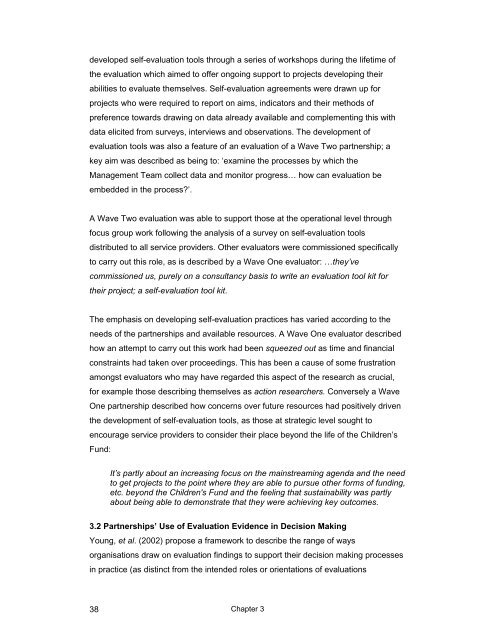Local Evaluation of Children's Services Learning from the Children's ...
Local Evaluation of Children's Services Learning from the Children's ...
Local Evaluation of Children's Services Learning from the Children's ...
- No tags were found...
Create successful ePaper yourself
Turn your PDF publications into a flip-book with our unique Google optimized e-Paper software.
developed self-evaluation tools through a series <strong>of</strong> workshops during <strong>the</strong> lifetime <strong>of</strong><strong>the</strong> evaluation which aimed to <strong>of</strong>fer ongoing support to projects developing <strong>the</strong>irabilities to evaluate <strong>the</strong>mselves. Self-evaluation agreements were drawn up forprojects who were required to report on aims, indicators and <strong>the</strong>ir methods <strong>of</strong>preference towards drawing on data already available and complementing this withdata elicited <strong>from</strong> surveys, interviews and observations. The development <strong>of</strong>evaluation tools was also a feature <strong>of</strong> an evaluation <strong>of</strong> a Wave Two partnership; akey aim was described as being to: ‘examine <strong>the</strong> processes by which <strong>the</strong>Management Team collect data and monitor progress… how can evaluation beembedded in <strong>the</strong> process?’.A Wave Two evaluation was able to support those at <strong>the</strong> operational level throughfocus group work following <strong>the</strong> analysis <strong>of</strong> a survey on self-evaluation toolsdistributed to all service providers. O<strong>the</strong>r evaluators were commissioned specificallyto carry out this role, as is described by a Wave One evaluator: …<strong>the</strong>y’vecommissioned us, purely on a consultancy basis to write an evaluation tool kit for<strong>the</strong>ir project; a self-evaluation tool kit.The emphasis on developing self-evaluation practices has varied according to <strong>the</strong>needs <strong>of</strong> <strong>the</strong> partnerships and available resources. A Wave One evaluator describedhow an attempt to carry out this work had been squeezed out as time and financialconstraints had taken over proceedings. This has been a cause <strong>of</strong> some frustrationamongst evaluators who may have regarded this aspect <strong>of</strong> <strong>the</strong> research as crucial,for example those describing <strong>the</strong>mselves as action researchers. Conversely a WaveOne partnership described how concerns over future resources had positively driven<strong>the</strong> development <strong>of</strong> self-evaluation tools, as those at strategic level sought toencourage service providers to consider <strong>the</strong>ir place beyond <strong>the</strong> life <strong>of</strong> <strong>the</strong> Children’sFund:It’s partly about an increasing focus on <strong>the</strong> mainstreaming agenda and <strong>the</strong> needto get projects to <strong>the</strong> point where <strong>the</strong>y are able to pursue o<strong>the</strong>r forms <strong>of</strong> funding,etc. beyond <strong>the</strong> <strong>Children's</strong> Fund and <strong>the</strong> feeling that sustainability was partlyabout being able to demonstrate that <strong>the</strong>y were achieving key outcomes.3.2 Partnerships’ Use <strong>of</strong> <strong>Evaluation</strong> Evidence in Decision MakingYoung, et al. (2002) propose a framework to describe <strong>the</strong> range <strong>of</strong> waysorganisations draw on evaluation findings to support <strong>the</strong>ir decision making processesin practice (as distinct <strong>from</strong> <strong>the</strong> intended roles or orientations <strong>of</strong> evaluations38Chapter 3
















